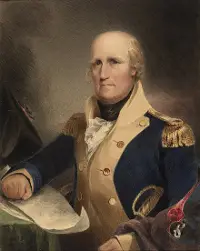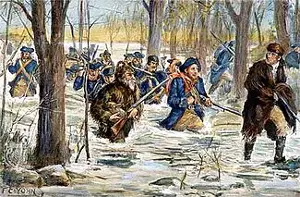George Rogers Clark: Hero of the Northwest
George Rogers Clark was a Revolutionary War hero who won a handful of key victories in the Northwest, paving the way for the American victory and later settlement of the area. 
Clark was born near Charlottesville, in Albemarle County, Va., on Nov. 19, 1752. His parents had nine other children, six of whom became officers during the Revolutionary War. (The youngest son was William, who with Meriwether Lewis explored the Louisiana Territory.) Although Clark benefited from little formal schooling, he did learn surveying from his grandfather. When he was 20, he rafted down the Ohio River, to the Kanawha River, and then visited the Ohio country, surveying all along the way. Clark served in the Virginia militia during Lord Dunmore's War, a conflict between the Virginia colony and the Mingo and Shawnee tribes in 1774, and was on the field at the Battle of Point Pleasant, the victory that brought about the end of the war. He found work surveying land in Kentucky for the Ohio Country and helped protect Kentucky from British and Native American attacks during the Revolutionary War. 
He went on the offensive in 1778 and 1779, raising a secret militia from North Carolina, Pennsylvania, and Virginia, and seized the outposts of Kaskaskia, Cahokia, and Vincennes, all strategic locations. Clark and his men took Vincennes twice, losing it in between to the British. Determined to retake the fort, Clark organized a new group of militia, and the 170 men marched 200 miles, at times through frozen floodwaters, and then convinced the British defending the fort that they were outnumbered. Clark had won the day. Among the spoils the second time around at Fort Sackville at Vincennes was the British commander, Henry Hamilton, who surrendered himself along with the fort. In 1779, Clark led an attack on Fort Detroit that did not succeed. In 1782, he had more success, defeating a determined group of Shawnee at the Battle of Piqua. (This was, in fact, more of a Pyrrhic victory because Clark lost a good deal of his men in the fight.) The surrender of a large number of troops at Yorktown convinced the British that the time was right for settlement, and the resulting Treaty of Paris ended the war in 1783. As part of the terms of this treaty, Great Britain surrendered all of the Old Northwest; George Washington and others gave Clark much credit for this result, and he came to be called the "Conqueror of the Old Northwest." Clark won an appointment as a commissioner of Native American relations after the war. In 1785, he helped negotiate the Treaty of Fort McIntosh, which restricted Native Americans to the northwest part of what is now Ohio. As part of the negotiation process, the Americans promised to respect the new settlement boundaries; other Americans did not do so, and violent conflicts followed. He led a large group of men in attacks against the tribes along the Wabash River; this particular group of soldiers caused him no end of trouble and eventually mutinied. Clark had his share of successes and failures during the war against the British and Native Americans. One decision he made early on in the war was eventually his financial undoing. He was the highest-ranking officer in the territory, and so he was the one responsible for requisitioning equipment and supplies and, of course, paying for them. He employed a mixture of cash payment and signing IOUs, anticipating that one of the state governments–likely Virginia–would reimburse him after the war. This did not happen, and Clark was at the mercy of a number of creditors. He found sporadic work, again as a surveyor, and tried to start a colony in Spanish Louisiana, but his debts dogged him for the rest of his days. He wrote his memoirs in the 1790s; they were not published in his lifetime. He lived in a cabin in Indiana for a time, in the town of Clarksville, named for him. In 1805, he was part of the surveying team that laid out the route of a canal around the Falls of the Ohio. He suffered a serious burn to a leg in 1809, and the leg had to be amputated. That same year, he suffered a stroke that left him paralyzed for a time. He moved to Louisville to live with his sister, Lucy. His last few years were not happy ones, and he died on Feb. 13, 1818. He was 65. |
|
Social Studies for Kids
copyright 2002–2024
David White




